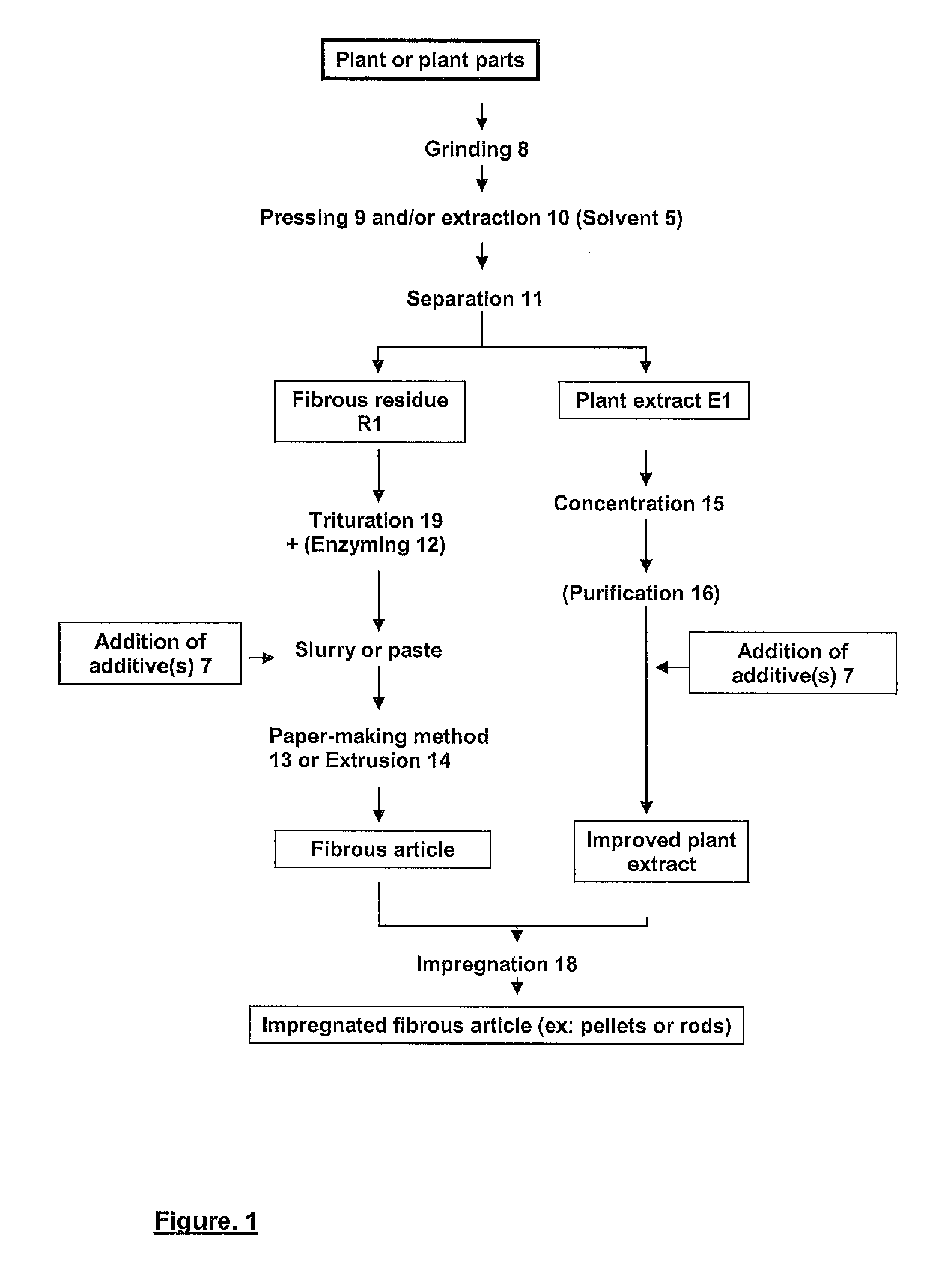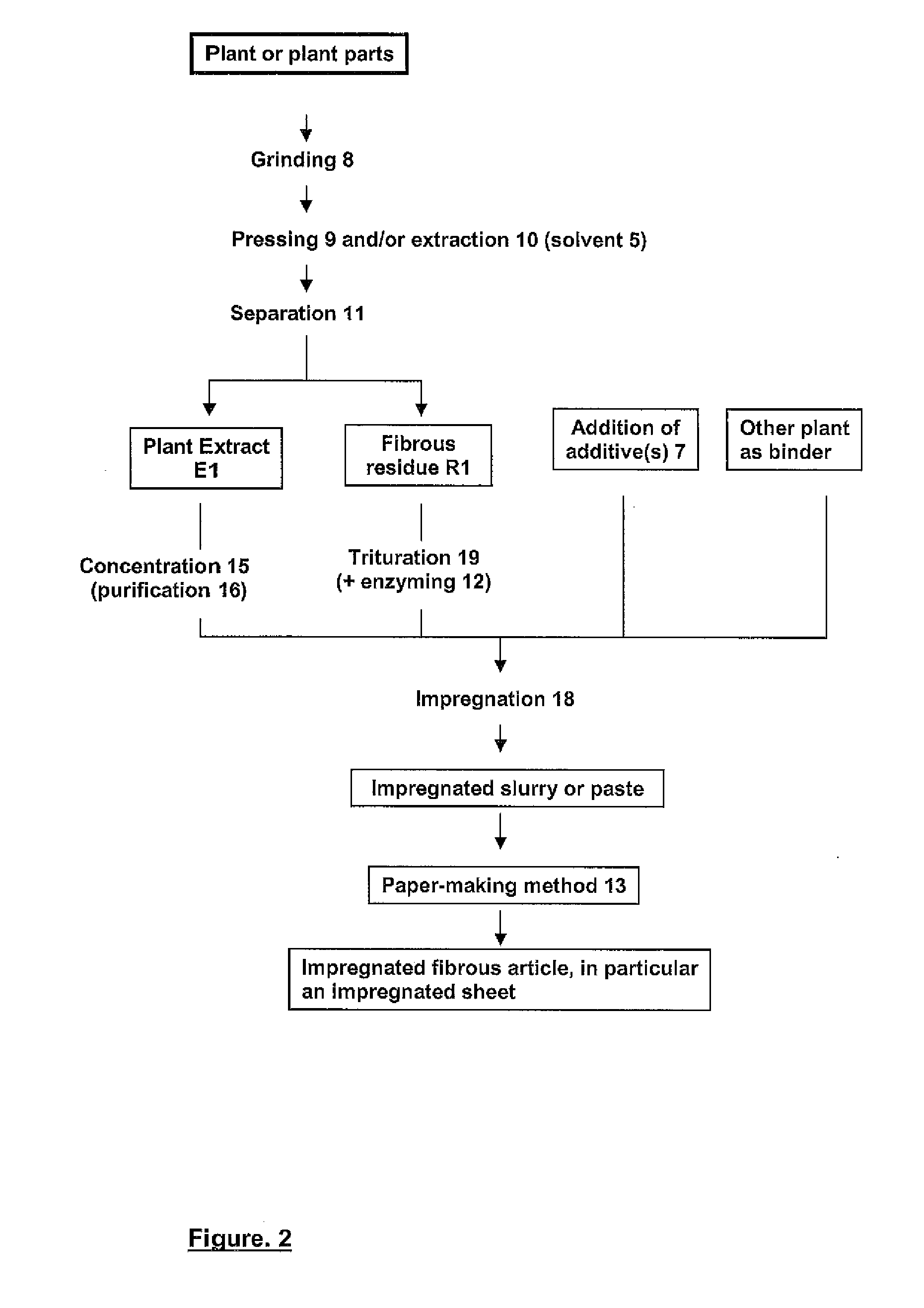Method For Producing Articles of Plant Origin Impregnated With a Liquid Plant Substance
a technology of liquid plant substance and plant origin, which is applied in the direction of packaging goods, plant/algae/fungi/lichens ingredients, sheet delivery, etc., can solve the problems of inability to fully or partially destroy the components, in particular biologically active components, and difficult industrial and personal extraction (for example, during the preparation of a cup of tea or herbal tea)
- Summary
- Abstract
- Description
- Claims
- Application Information
AI Technical Summary
Benefits of technology
Problems solved by technology
Method used
Image
Examples
example 1
2)
[0129]The method consists of coarsely grinding, by shearing, blossoms (flowers, stems and leaves) of fresh mint (Mentha x piperita) and extracting the active ingredients from the water (ground plant / water ratio 1 / 5, at a temperature kept at 60-70° C. for 15 min. with agitation), then separating the soluble extract from the insoluble parts by mechanical pressing. The operation is repeated 2 times.
[0130]The first extract is half concentrated by evaporation and the fibrous fraction is triturated in the presence of water (rotor / stator dispersion / homogenization by an Ultra-Turrax IKA) until a paste is formed.
[0131]A liquid solution of 10% menthol is prepared and kept at 40° C.
[0132]1% of the products and all of the concentrate are then mixed with the destructured mint insolubles alone or mixed with finely pulverized tea leaves (Camelia sinensis) and / or leaves and stems of Stevia rebaudiana and forming, by pouring or extrusion of said mixture, a reconstituted sheet. The sheet can then b...
example 2
3)
[0133]The method consists of hydrogen distilling, at atmospheric pressure, 100 g of dried rosemary blossoms (Rosmarinus officinalis) (mixture of tough leaves, fibrous stems, twigs and flowers) by 2 l of steam. Then, after condensation of the steam and cooling, the method consists of separating the upper phase, i.e., approximately 0.5 mL of essential oil, from the lower phase (white water for approximately 1.5 l).
[0134]The essential oil is a very fluid, colorless to pale yellow fluid. It is known for containing borneol, cineole, camphene, pinene and chlorogenic acid. The rosmarinic acid, which is a powerful antioxidant, is divided between the aqueous phase, the essential oil and the solid residue. The floral water or white water is concentrated 5 times under vacuum at a temperature not exceeding 60° C., then is added to the insoluble residue of the distillation of the rosemary.
[0135]The whole is agitated violently (Ultra turax IKA) until it forms a paste, which is sown by an enzyme...
PUM
| Property | Measurement | Unit |
|---|---|---|
| weight ratio | aaaaa | aaaaa |
| pressure | aaaaa | aaaaa |
| pressure | aaaaa | aaaaa |
Abstract
Description
Claims
Application Information
 Login to View More
Login to View More - R&D
- Intellectual Property
- Life Sciences
- Materials
- Tech Scout
- Unparalleled Data Quality
- Higher Quality Content
- 60% Fewer Hallucinations
Browse by: Latest US Patents, China's latest patents, Technical Efficacy Thesaurus, Application Domain, Technology Topic, Popular Technical Reports.
© 2025 PatSnap. All rights reserved.Legal|Privacy policy|Modern Slavery Act Transparency Statement|Sitemap|About US| Contact US: help@patsnap.com



